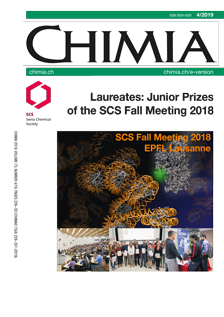Mechanistic Understanding of Halogen-mediated Catalytic Processes for Selective Natural Gas Functionalization
DOI:
https://doi.org/10.2533/chimia.2019.288PMID:
30975258Keywords:
Halogen-mediated selective alkane functionalization, Heterogeneous catalysis, Natural gas, Operando spectroscopy, Reaction mechanismAbstract
Development of catalytic technologies enabling the direct functionalization of light alkanes, main components of abundant natural gas, into value-added chemicals and liquid fuels is quite possibly the key strategy to transit from the oil to the renewables era. A cornerstone to meet this great challenge comprises the in-depth understanding of complex reaction mechanisms over dynamic surfaces, allowing to elucidate catalyst design criteria for selective alkane functionalization processes. Prominent examples are the oxybromination of methane into bromomethanes (CH3Br+CH2Br2) and the oxychlorination of ethane into ethylene, which are the two highly selective routes (selectivity ≤98.5%) that have been proposed to involve gas-phase pathways or purely surface-driven reactions, respectively. Herein, we review our recent efforts to uncover these complex reaction schemes that combine kinetic analysis with advanced operando characterization techniques, including prompt-gamma activation analysis and photoelectron photoion coincidence spectroscopy, ultimately rationalized by density functional theory calculations. In particular, alkane activation to methyl bromide in oxybromination was found to occur in the gas-phase with evolved bromine and bromine radical species, thus enabling to decouple the formation of highly reactive methane-derived intermediates from the catalyst surface that are prone towards combustion. In contrast, the selectivity control in ethane oxychlorination is achieved via a purely surface-driven functionalization of ethane into ethyl chloride, which is further dehydrochlorinated to ethylene over chlorine modified active centers.
Downloads
Published
Issue
Section
License
Copyright (c) 2019 Swiss Chemical Society

This work is licensed under a Creative Commons Attribution-NonCommercial 4.0 International License.







